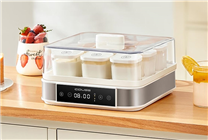The Decline of Home Appliances: From Must-Have to Unused
Summary:
- Many trendy home appliances become idle due to unrealistic expectations and impulsive buying.
- Understanding consumer behavior and evaluating true needs can lead to more rational purchases.
- Repurposing or properly disposing of unused appliances can reduce waste and enhance your living space.
The age of modern kitchen gadgets has brought us innovative appliances that promised to simplify our lives. Yet, many of these items end up gathering dust in cupboards. What once seemed like essential tools have transformed into mere clutter. What causes these high hopes to crumble into disappointment?
The Trendy Appliance Trap
In recent years, the rise of social media marketing has led many consumers to purchase home appliances that appear revolutionary but fail to meet expectations.
Small Kitchen Appliances
Take yogurt machines, for example. Marketed as a healthy alternative, they require meticulous preparation and lengthy production times—often resulting in a tedious process rather than the anticipated convenience. A staggering 68% of yogurt machines sit unused, as many consumers find them too cumbersome for occasional use.
Similarly, air fryers surged in popularity for their promise of healthier cooking. However, their limitations quickly become apparent. Many households find these appliances difficult to clean and unsatisfactory for producing desired meal quality. After a few months of use, air fryers often end up tucked away, igniting a nostalgic faux pas of hope that runs counter to their less-than-stellar performance.
Specialized Appliances
Niche appliances, like mite removers and steam mops, often fail to deliver on their promises. While marketed as solutions to specific problems, their actual utility pales compared to traditional cleaning methods. Consumers soon realize that manual operation and additional components make these appliances less appealing, diminishing their use and relegating them to storage.
Likewise, breakfast machines designed to prepare multiple components simultaneously may seem convenient but often lack efficiency and require tedious cleanup, resulting in rejection in favor of classic dishware.
Unpacking Consumer Mindset
The accumulation of unused home appliances signifies a broader issue that extends beyond product quality—it lies within the consumer psychology that drives purchasing decisions:
False Demand Creation
Influencer marketing often showcases flawless interactions with home appliances, obscuring the time and effort required. This misrepresentation lures consumers into believing that they will easily replicate these results, leading to regretted purchases.
The Allure of Multi-functionality
Today’s consumers often desire multi-functional appliances but may discover that versatility comes at the cost of effectiveness. For instance, a high-powered blender may not perform equally across various tasks, causing it to underperform in specific areas. Consequently, users may find themselves with a kitchen gadget that doesn’t satisfy any single requirement well.
Idealized Living Conditions
Consumers frequently romanticize the notion of their future lifestyles, leading them to purchase appliances that don’t match their current habits. The gap between expectation versus reality can lead to appliances that are quickly forgotten, as busy schedules often overshadow grand intentions of home cooking.
Impulse Buying
Promotional discounts on popular home appliances often lead to impulsive purchases devoid of actual necessity. Research indicates that a significant portion of appliances bought during sales are seldom put to use, highlighting the susceptibility of consumers to price temptations over genuine need.
Navigating the Useless Trap
With a plethora of options available, how can consumers avoid falling prey to impulse buying?
Purchase Mindfully
Prior to making a purchase, ask yourself three critical questions:
- Frequency of Use: Will this appliance be used daily, weekly, or rarely?
- Irreplaceability: Can its function be fulfilled by your existing appliances?
- Cost of Use: Are there ongoing expenses or maintenance requirements that might render it impractical?
Answering these queries can help filter out unnecessary items.
Optimize Existing Appliances
Instead of discarding unwelcome appliances, explore creative usage scenarios. For instance, an air fryer can warm leftovers, while a yogurt machine could be repurposed for fermenting dough.
Responsible Disposal
If dispossession is necessary, avoid simply throwing appliances away. Consider these options:
- Resell: Platforms for second-hand items can help recover some costs while giving appliances a new life.
- Donate: Functional appliances can make a difference in community organizations.
- Trade-in: Many brands offer trade-in programs to facilitate eco-friendly next purchases.
Conclusion: Embrace Rational Consumption
Home appliances should serve as tools to enhance daily living, not liabilities that clutter our homes. To ensure that our appliances elevate our lives, we need to practice informed purchasing habits that prioritize genuine needs over fleeting trends.
By rejecting superficial demands and focusing on meaningful consumption, we can shift the paradigm of home appliances from mere trends to essential tools that contribute positively to our lives. After all, the joy of living lies not in the number of gadgets we own but in their practical utility.








